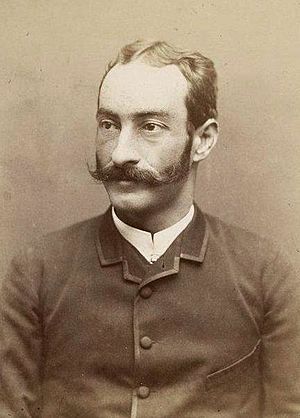Roberto Ivens facts for kids
Quick facts for kids
Roberto Ivens
|
|
|---|---|
 |
|
| Born | 12 June 1850 |
| Died | 28 January 1898 (aged 47) Oeiras, Portugal
|
| Nationality | Portuguese |
| Occupation | Navy officer, explorer, geographer, colonial administrator |
| Known for | First European (alongside Hermenegildo Capelo) to cross Central Africa from coast to coast between Angola and Mozambique. |
| Military career | |
| Allegiance | |
| Service/ |
|
| Years of service | 1861–? |
| Signature | |
Roberto Ivens was a brave Portuguese explorer, geographer, and a skilled officer in the Portuguese Navy. He was born on June 12, 1850, in Ponta Delgada, Portugal, and passed away on January 28, 1898, in Oeiras. Ivens is famous for being one of the first Europeans to cross Central Africa from one side to the other, a truly amazing journey!
Contents
Roberto Ivens came from a good family. His grandfather, William Ivens, was a merchant who received a special family symbol, called a Coat of Arms, from King George III in 1816.
In 1861, when he was just 11 years old, Roberto started studying at the Navy School in Lisbon. He was known as "Roberto of the Devil" at school, but he was also very smart. He joined the Portuguese Navy in 1870 when he was 20. The next year, he went to the Suez Canal as part of the crew on a ship called the Estefânia.
Amazing Journeys and Discoveries

Roberto Ivens began his exciting travels in Angola in 1872. He spent three years exploring different colonies. After returning to Portugal in 1875, he became a lieutenant. Soon after, he sailed to Portuguese São Tomé and Príncipe and other ports in South America.
In 1876, Ivens even traveled to the United States. He brought Portuguese products to an event called the Centennial Exposition in Philadelphia.
One of his most important expeditions started in 1877. He went into the areas of Angola and Mozambique. He studied how different rivers and water systems were connected, especially around the Zambezi River. His studies were so good that people still admire them today! In the same year, he was promoted to first lieutenant.
His most famous journey began on June 21, 1885. King Luís I of Portugal asked Ivens to travel all the way between Angola and Mozambique. This was after a big meeting called the Berlin Conference, where European countries discussed how to divide Africa. Ivens's journey covered over 4,500 miles (about 8,300 km), and a huge part of it was land that no one had ever mapped before! This incredible trip was called the "Contracosta" expedition.
Because of his great service to Portugal, Roberto Ivens was given the special job of aide-de-camp to King Luís. In 1895, he received an important award, becoming an Officer of the Order of Aviz. He also became the secretary of the Cartography Commission, which was in charge of making maps.
Honours and Legacy
Roberto Ivens is still remembered and honored in Portugal today. Ten streets are named after him, including a main avenue in his hometown of Ponta Delgada. Several schools also carry his name, like the Escola Básica Integrada Roberto Ivens.
Even a type of African lizard, Lubuya ivensii, is named after him! He was also featured on the 500 Angolan escudo banknote in 1956.
Works by Roberto Ivens
- De Benguela às Terras de Iaca (1881)
- De Angola à Contracosta (1886)
See also
 In Spanish: Roberto Ivens para niños
In Spanish: Roberto Ivens para niños

